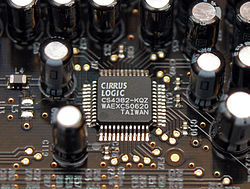Komputer adalah alat yang dipakai untuk mengolah data menurut prosedur yang telah dirumuskan. Kata computer semula dipergunakan untuk menggambarkan orang yang perkerjaannya melakukan perhitungan aritmatika, dengan atau tanpa alat bantu, tetapi arti kata ini kemudian dipindahkan kepada mesin itu sendiri. Asal mulanya, pengolahan informasi hampir eksklusif berhubungan dengan masalah aritmatika, tetapi komputer modern dipakai untuk banyak tugas yang tidak berhubungan dengan matematika. (wikipedia)
bagian dasar komputer :
1> input device
2> central processing unit (CPU)
3> output device
4> external memory
1>input device
Input device bisa diartikan sebagai peralatan yang berfungsi untuk memasukkan data ke-dalam komputer. Jenis input device yang dimiliki oleh komputer contoh nya, keyboard, mouse, light-pen, scanner,finger print, dll
2>central proocessing unit (cpu)
Bagian ini berfungsi sebagai pemegang kendali dari jalannya kegiatan komputer, dan dikarenakan itu, CPU juga disebut sebagai otak dari komputer. Selain dari pada itu, CPU juga berfungsi sebagai tempat untuk melakukan pelbagai pengolahan data. Pekerjaan pengolahan data diantaranya: mencatat, melihat, membaca, membandingkan, menghitung, mengingat, mengurutkan maupun membandingkan.
Dalam bekerja, fungsi dari CPU terbagi menjadi :
- Internal Memory/Main Memory, berfungsi untuk me-nyimpan data dan program.
- ALU (Arithmatic Logical Unit), untuk melaksanakan perbagai macam perhitungan.
- Control Unit, bertugas untuk mengatur seluruh operasi komputer
3>output device
Output device bisa diartikan sebagai peralatan yang berfungsi untuk mengeluarkan hasil pemrosesan ataupun pengolahan data yang berasal dari CPU kedalam suatu media yang dapat dibaca oleh manusia ataupun dapat digunakan untuk penyimpanan data hasil proses. Jenis output device yang dimiliki oleh komputer printer, monitor,plotter,voiceres, dll
4> external memory
External memory bisa diartikan sebagai memory yang berada diluar CPU. Juga disebut sebagai Secondary Storage ataupun Backing Storage ataupun Memory Cadangan yang berfungsi untuk menyimpan data dan program. Data dan program yang tersimpan didalam external memory, agar bisa berfungsi data dan program tersebut harus dipindahkan terlebih dahulu kedalam internal memory. Jenis external memory antara lain disket, hard-disk, tape, cd, flash disk, card dll
Sedangkan yang disebut dengan program adalah kumpulan instruksi atau perintah terperinci yang sudah dipersiapkan supaya komputer dapat melakukan fungsinya dengan cara yang sudah tertentu. program juga merupakan suatu interface antara manusia dengan komputer.
Bit = satuan paling dasar dalam jaringan “organ” komputer, atau bagian dalam komputer. Pada dasarnya bilangan bit merupakan perwakilan aliran listrik, yakni hanya ada 2 saja yaitu 1 dan 0, yang bisa disebut 1 = ada listrik dan 0 = tidak ada listrik.
Byte = nah, ini baru satuan paling dasar komputer. 1 byte terdiri dari 8 bit. Oleh karena itu 1 byte bisa mewakili angka sampai 255, (kalau dijelaskan panjang, karena hubungan ama matematika, singkatnya bilangan 15 desimal = 1111 dalam bilangan bit). byte bisa juga mewakili 1 karakter komputer.
file = Arsip yang disimpan dalam suatu media, yang terdiri dari kumpulan karakter, dan didokumentasikan dalam bentuk data digital oleh komputer.
field = Di dalam database diartikan sebagai identitas spesifik dari sebuah objek. Misal objeknya mobil, field warnanya biru, field bahan bakar solar, dst.
1. Sistem Operasi, merupakan perangkat lunak yang mengoperasikan komputer serta menyediakan antarmuka dengan perangkat lunak lain atau dengan pengguna.
Contoh sistem operasi : MS DOS, MS Windows (dengan berbagai generasi),
Macintosh, OS/2, UNIX (dengan berbagai versi), LINUX (dengan berbagai
distribusi), NetWare, dll
2. Program Utilitas, merupakan program khusus yang berfungsi sebagai perangkat pemeliharaan komputer, seperti anti virus, partisi hardisk, manajemen hardisk, dll. Contoh produk program utilitas : Norton Utilities, PartitionMagic, McAfee, dll
3. Program Aplikasi, merupakan program yang dikembangkan untuk memenuhi kebutuhan yang spesifik. Contoh : aplikasi akuntansi, aplikasi perbankan, aplikasi manufaktur, dll
Keuntungan PC (Personal Computer) :
1. Tidak memakan tempat, karena bentuk nya tidak besar (seperti mainframe)
2. Bisa digunakan sebagai client atau server. Dan bisa juga standalone
3. General Purpose, merupakan komputer yang dikembangkan untuk kebutuhan umum.
Copy : menduplikat file asli tanpa harus menghapuss file asli tersebut ditempat(folder) aslinya
Cut : memindahkan file asli dari tempat(folder) awal ketempat(folder) yang diinginkan. File asli ditempat(folder) awal akan terhapus.
from : http://nugroz.wordpress.com
 DRAM disebut memori dinamis karena harus direcharge (diperbaharui muatan listriknya) secara periodik karena pengaruh sifat kebocoran muatan yang dimiliki oleh kapasitor yang dipakai untuk membuat sel-sel memori dari DRAM. Kelebihan DRAM adalah lebih murah dan lebih mudah rangkaiannya sehingga satu chip DRAM dapat memuat sel bit data jauh lebih besar dari SRAM.
DRAM disebut memori dinamis karena harus direcharge (diperbaharui muatan listriknya) secara periodik karena pengaruh sifat kebocoran muatan yang dimiliki oleh kapasitor yang dipakai untuk membuat sel-sel memori dari DRAM. Kelebihan DRAM adalah lebih murah dan lebih mudah rangkaiannya sehingga satu chip DRAM dapat memuat sel bit data jauh lebih besar dari SRAM. SDRAM digunakan pada cache memori internal (L1) dan memori eksternal (L2) dari prosesor. Sedangkan DRAM dipakai pada chip penyusun modul memori yang terpasang di motherboard.
SDRAM digunakan pada cache memori internal (L1) dan memori eksternal (L2) dari prosesor. Sedangkan DRAM dipakai pada chip penyusun modul memori yang terpasang di motherboard.

 Processor atau CPU (Central Processing Unit) merupakan otak dari komputer yang melakukan pemerosesan dan operasi perhitungan dan logika terhadap instruksi program yang diberikan ke komputer.
Processor atau CPU (Central Processing Unit) merupakan otak dari komputer yang melakukan pemerosesan dan operasi perhitungan dan logika terhadap instruksi program yang diberikan ke komputer.
















